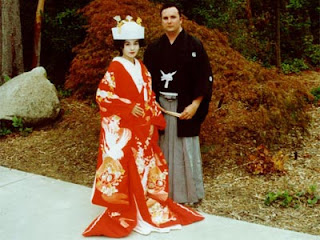


The Perfect Japanese Dress For Your Wedding - Choosing a Traditional Dress
Every country has different traditions and customs that is why during the wedding ceremony the bride and the groom wear their traditional dresses. Weddings are celebrated with great enthusiasm and zeal in Japan. The close family members and friends of the bride and groom are invited to the wedding and the ceremony is mainly organized in a very simple manner. Most of the weddings in Japan are held in autumn and spring and organized in a Shinto temple. Before the wedding is planned an auspicious date is chosen so that it can bring luck for the bride and groom.
In this article, I would mainly like to tell you about the Traditional Japanese dress and the accessories that are worn by the Japanese bride.
1. The wedding dress
On the wedding day the Japanese bride looks extremely beautiful because their whole body is painted white. It is a belief in the Japanese culture that painting the bride white, would bring luck and prosperity in her married life. The wedding dress for a Japanese bride usually consists of a complete white kimono which is generally white in color. The kimono is known as shiro-maku. In order to get the perfect look for their wedding day, the brides also make different and elaborate hair styles that are done with the help of various hair accessories and comb.
2. Wedding accessories
Various different accessories are used for dressing up the Japanese bride. A hood is used for covering the head of the bride during the ceremony. This hood signifies that the bride would make a very patient and understanding wife. It is a tradition in Japan that the bride has to carry some additional accessories that are either borrowed or given to them by their elders. The accessories that they usually carry are the sheathed dagger which is known as the kaiken and a very delicate sack purse which is known as the hakoseko.
3. Simple and elegant
The Japanese bridal outfit is very simple and elegant. During the ceremony the bride also wears the tsuno-kakushiover which marks her eagerness to enter into this great institution. During the reception the bride has to change her clothes a number of times. The brides wear the uchikake during the reception and it is usually made of silk and dyed in red color.
I am sure this article would certainly be able to provide you all the information that you need about Japanese wedding dress.
1. The wedding dress
On the wedding day the Japanese bride looks extremely beautiful because their whole body is painted white. It is a belief in the Japanese culture that painting the bride white, would bring luck and prosperity in her married life. The wedding dress for a Japanese bride usually consists of a complete white kimono which is generally white in color. The kimono is known as shiro-maku. In order to get the perfect look for their wedding day, the brides also make different and elaborate hair styles that are done with the help of various hair accessories and comb.
2. Wedding accessories
Various different accessories are used for dressing up the Japanese bride. A hood is used for covering the head of the bride during the ceremony. This hood signifies that the bride would make a very patient and understanding wife. It is a tradition in Japan that the bride has to carry some additional accessories that are either borrowed or given to them by their elders. The accessories that they usually carry are the sheathed dagger which is known as the kaiken and a very delicate sack purse which is known as the hakoseko.
3. Simple and elegant
The Japanese bridal outfit is very simple and elegant. During the ceremony the bride also wears the tsuno-kakushiover which marks her eagerness to enter into this great institution. During the reception the bride has to change her clothes a number of times. The brides wear the uchikake during the reception and it is usually made of silk and dyed in red color.
I am sure this article would certainly be able to provide you all the information that you need about Japanese wedding dress.









